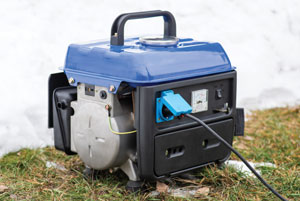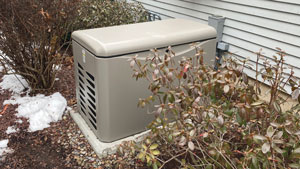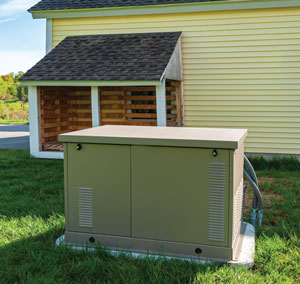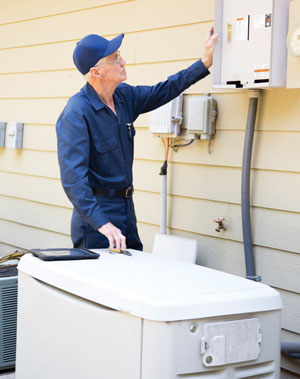POWERING UP

BE PREPARED FOR EMERGENCIES WITH A HOME GENERATOR
Winter is coming. That means fun-filled snow days – but also ice storms, sleet and the possibilities of power outages. One way to secure your home and have peace of mind is to invest in a generator, so you’ll have power even if the rest of the block is dark.
The time to investigate purchasing and installing a generator is before the emergency. Unless you have significant experience installing a generator yourself, hire a professional. Some high stakes errors could lead to burns, shocks and carbon monoxide poisoning.
Generators are available in different sizes, depending on the power needed, and there are different types of generators to choose from. They can run on gasoline, propane, diesel, natural gas or solar energy. Noise levels can range from 50-100 decibels.
Let’s explore your options.
 Portable generators
Portable generators
Portable generators can be set up in an open space and are meant to support a few appliances. Power can be delivered via extension cord, or you can have a transfer switch installed, which allow some parts of your overall electrical system to function. There are also portable “inverter” generators that can be cranked up or down depending on how much power you need.
Portables will run for about 8 to 10 hours before they need refueling and can be a little more elaborate, with exhaust systems that help keep the noise level down. And finally, there are also solar generators, which are much lighter and quieter.
 Whole-house generator
Whole-house generator
When most people think of home generators, they are usually thinking of larger “whole house” generators, also called standby generators. The downside to these units? They are expensive, permanent and large. The upside? They give your home significant auxiliary power.
They are hard-wired and are usually connected to a large reserve of fuel, like a gas tank or a propane gas line. They also require professional installation by experts with knowledge of local building codes and familiarity with the necessary testing and inspections. These turn on when the power cuts off and flip back off when your primary power returns — which would also help when you are away. If the power cuts out in a storm while you are out of town, a whole-house generator will kick in on its own, saving your food from spoiling and keeping security systems active. If you are home and require the use of any medical devices, these can literally be lifesavers. Additionally, if you have a well pump, a generator can keep your water flowing when the electricity is out.
 The size of the generator you need depends on what percentage of your home you want powered. The whole house or maybe a few key areas like your kitchen? A licensed professional can advise on what you need, although you can estimate how much wattage you use by checking the labeling on specific appliances, or just look at the daily average on your electric bill. Getting the biggest unit possible might waste a lot of gas and money providing more power than you use. On the flip side, you wouldn’t want to get the smallest unit, only to find it doesn’t meet your needs.
The size of the generator you need depends on what percentage of your home you want powered. The whole house or maybe a few key areas like your kitchen? A licensed professional can advise on what you need, although you can estimate how much wattage you use by checking the labeling on specific appliances, or just look at the daily average on your electric bill. Getting the biggest unit possible might waste a lot of gas and money providing more power than you use. On the flip side, you wouldn’t want to get the smallest unit, only to find it doesn’t meet your needs.
What is a transfer switch?
Transfer switches safely connect your generator to a circuit panel via a cable and allow you to switch between grid power and generator power.
— “This Old House”
 Cost & installation
Cost & installation
Work with an expert to get a solid estimate on a whole-house generator based on what you want powered, factoring in the additional cost to have it installed. Prices can range from as low as $1,500 up to $12,000 depending on size, brand, etc. Portables can cost as much as $2,500 or as little as a few hundred dollars. When choosing a generator, look for brands and models that hold a UL, Intertek ETL or CSA rating. If you live in an older home, you may also need to consult an electrician on the wiring.
Generators need to be installed outside, well away from doors and windows, and with clearance above and on the sides to prevent carbon monoxide poisoning. Never bring portable generators inside for that same reason. To be extra safe, if buying a portable, choose one with a safety shutoff that detects unsafe levels of carbon monoxide.
Ongoing care & use
Once installed, follow all manufacturer instructions for use. You also need to maintain your generator in between uses, so budget a few hundred dollars a year for servicing. Consult the manufacturer’s manual for routine care, including turning it on at regular intervals. And definitely leave repairs to the professionals.
If you are getting a portable unit, you can visit the website of the Portable Generator Manufacturersʼ Association at pgmaonline.com to learn more. To find out more information on standby units, you can visit the Electrical Safety Foundation website at esfi.org. Stay safe, do your homework now and plan for installation long before the first snowflake hits the ground. ✦
diesel, gasoline, home generator, natural gas, portable generators, power outages, propane, solar energy, transfer switch, whole-house generator






